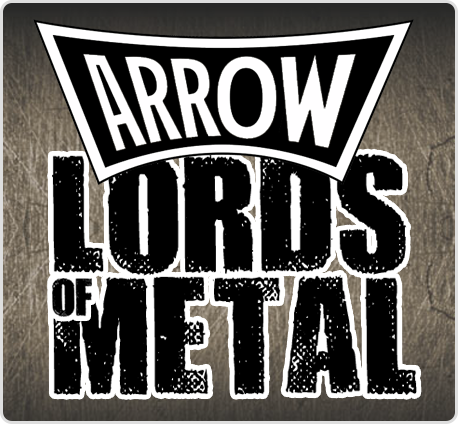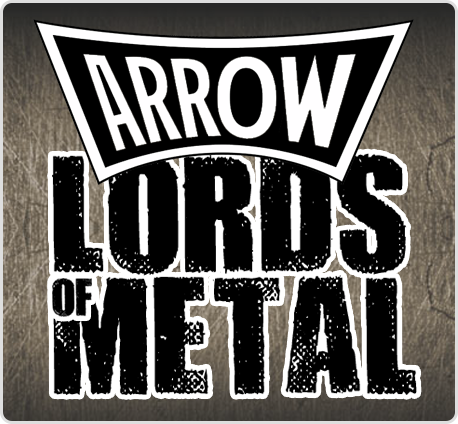
Dave Mustaine – a life in guitars
“We can’t confirm, but sometimes you just have to let a cool story be a cool story.”
Today Gibson Guitars and Megadeth frontman Dave Mustaine announced a new collaboration. With that cooperation, Mustaine ends a 13 year old endorsement deal at Dean Guitars. He already announced his departure 2 months ago. But Dean wasn’t his first guitar supplier. We made an overview of all known guitars and companies we could find Megadave has played with.
Door: Ramon van Hengel Ι 23 februari 2021
Dave Mustaine’s career is one of the most illustrious ones in metal. As the fired solo guitarist for Metallica, he was determined to get his revenge with his own band Megadeth, in which he plays rhythm guitar, solo guitar, sings and is the main composer and released several all-time classic thrash metal albums. The biggest compliment he was given was by renowned music journalist Joel McIver’s, who placed him at number one in “The 100 Greatest Metal Guitarists” of all times. Despite also calling him a dick. Well, if someone who hates you acknowledges your greatness, it counts double. Mustaine has had some long lasting endorsement deals, some of which ended unexpectedly. These are all his guitars we could find in booklets, Wikipedia and guitar pages.
Les Paul copy of unknown origin
Mustaine’s first ever band was Panic. There is little known about his exact gear setup in this period, but the few pictures that are available show him with what appears to be an imitation Tobacco Burst Les Paul, with double humbuckers. Don’t worry, we’ll get more precise after this one. The guitar in the picture is an original Les Paul, that his guitar showed similarity to.
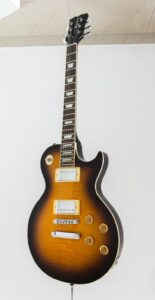
B.C. Rich Bich Perfect 10 Natural Koa
Still in panic (pun intended) and during his entire stint with Metallica, his short-lived band Fallen Angels and probably during the early days of Megadeth, Dave Mustaine played this B.C. Rich. This was the guitar that Kerry King saw him play solos with, without even looking on his hands. Impressed by this ability, plus the connection of the two of them both playing B.C. Rich, made King accept Mustaine’s invitation to join Megadeth. A cooperation that lasted roughly 3 weeks and was always intended to get the attention to Slayer, for King. Mustaine quoted King as “one of the best rhythm guitarists in the world“.
The guitar had distinct features that appealed and continues to appeal a lot of heavy metal players. It had a natural finish, since in those days you had to deal with what the local guitar store had available for you. He later repainted it black himself.
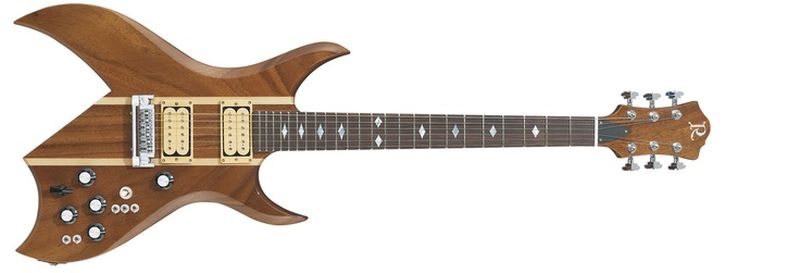
Ibanez Destroyer II D400
A guitar that might not be as controversial as its player, but the Ibanez Destroyer was subject to a major lawsuit filed by (the irony) Gibson against Ibanez, for resembling the Explorer model too much. The model gained popularity fast and Venom vocalist Cronos played the bass version of this guitar during ‘Black Metal’, at least on stage. Other famous guitarists who played the Destroyer include Eddie van Halen, Florens Versluis, Adrian Smith, Tom Angelripper and Quortuon. This guitar also took Mustaine through playing in Metallica, although there is very little footage of him playing it.
Mustaine’s version had a cherry sunburst finish with dot inlays and an Ibanez Super 58 humbucker pickup in the neck and Ibanez V2 in the bridge.
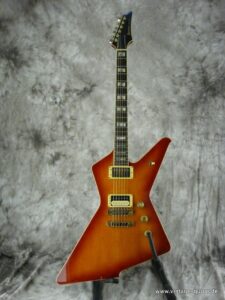
B.C. Rich Bich Perfect 10 Black
This was Mustaine’s main axe throughout the first years of Megadeth. He was first seen with it in 1984 and he played it until 1987. It was however not his exclusive guitar, as you can see him play a Jackson in ‘Wake Up Dead’, but he was playing the Bich in the video for ‘Peace Sells… But Who’s Buying’. Another distinctive feature on the guitar can be found on the neck, with the inlays.
The Bich guitar has a special feature with 4 additional strings, but Mustaine never used those. The two original pickups were replaced with Bill Lawrence humbuckers (most likely L500s), all of the gold-plated hardware was kept. He also adorned this one with stickers. There is a story that Chris Poland sold this particular guitar of Dave’s without his permission, which resulted in his unvoluntary resignation. We can’t confirm, but sometimes you just have to let a cool story be a cool story.
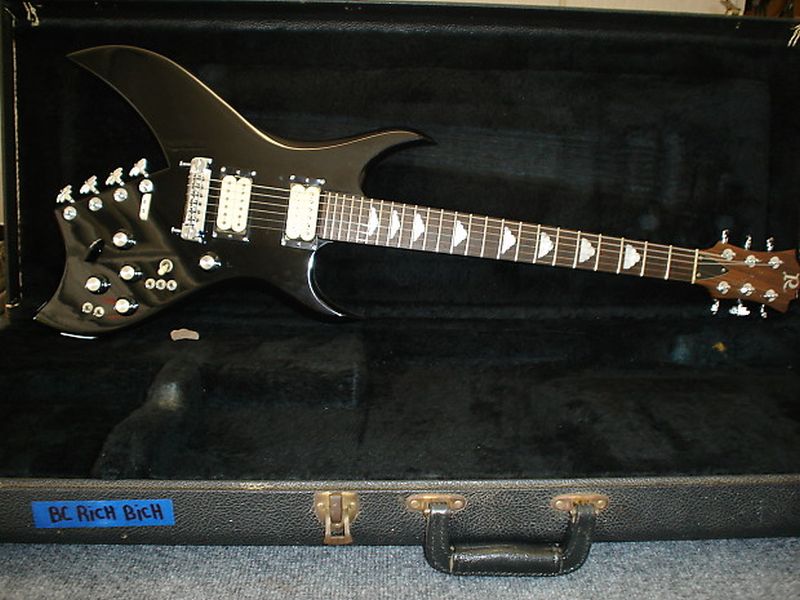
1980s Jackson King V
Dave Mustaine had no deal with Jackson Guitars, when he got his first piece during the ‘Peace Sells’ era: a white King V, which he modified heavily. He narrowed the neck down by sanding it and he put stickers on them. The sanding could have been done to make the finish on the neck less sticky. He was seen using the guitar with stickers on it, on and off.

1986 Jackson King V Custom
Now a lot more experienced and pickier, he ordered this King V from Jackson. It has a thinner neck than Jackson had had at the time, it had a Kahler fixed bridge, Seymour Duncan JB pickup in the bridge position and a Bill Lawrence 500L in the neck. This would become the first Dave Mustaine Signature King V.
The videos for ‘Wake Up Dead’ and ‘No More Miste Nice Guy’ showed him sporting this guitar, the black King V signature model. The white one is said to be the model on which all his later signature models are based.
Jackson saw how successful the cooperation with Mustaine was and it became one of their top sellers. Over the years, from 1986 to 1992, some minor adjustments were made, among which the pickups.
1980s Jackson King V “Number One”
Dave Mustaine’s main guitar throughout his commercially most successful years, the grey finished guitar (or more precise “silver sparkle”) has been a trademark guitar for Mustaine for the albums ‘So Far, So Good… So What!’, ‘Rust In Peace’, ‘Countdown To Extinction’, ‘Youthanasia’ and ‘Cryptic Writings. He used several guitars during these years, but this was the main one. By this time, band mates Marty Friedman and Dave Ellefson also played Jackson and both of them still do to this date. ‘Hangar 18’, ‘Holy Wars’, ‘Sweating Bullets’ and all the other big hits of the band were made and played on this piece. This was THE guitar you could tell Mustaine by, like the Les Paul on Slash and the Jem on Steve Vai. He however had some other noteworthy guitars with Jackson too.
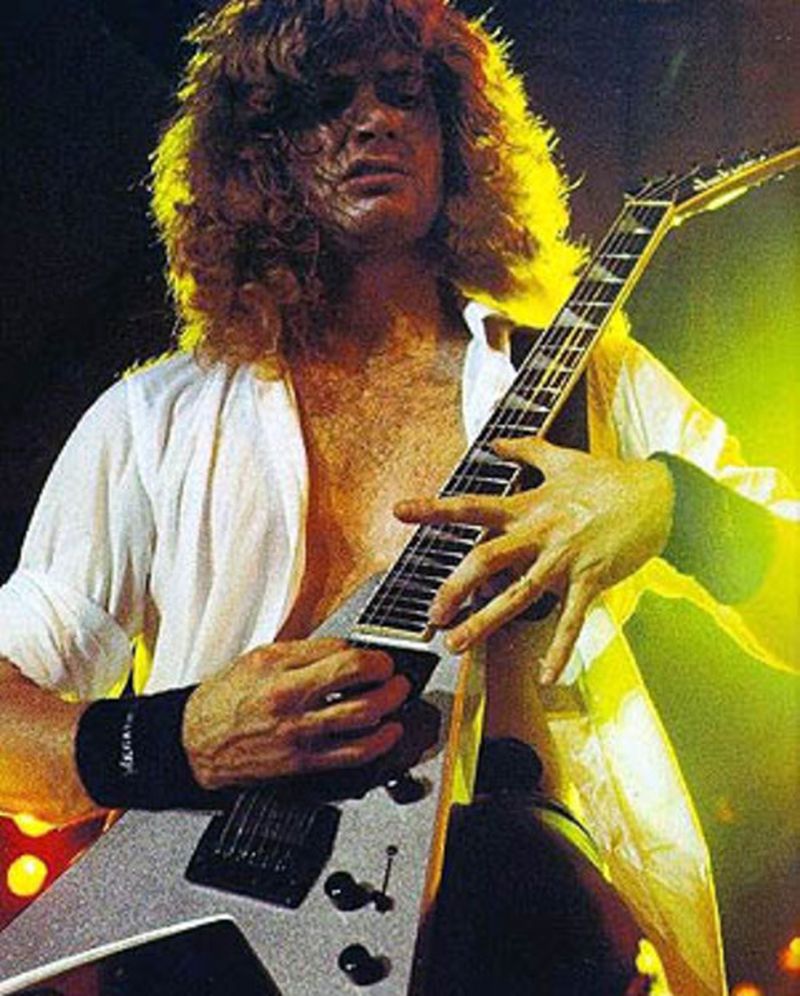
Jackson King V Doubleneck
A guitar that was both absurd and sensational, the King V Doubleneck was used on ‘Mary Jane’ and the classic ‘In My Darkest Hour’ and could be seen with Dave Mustaine playing these songs live. The top neck had 12 strings, with a Jackson J-92C pickup, the lower neck had a 6 string configuration with bridge and neck pickups.
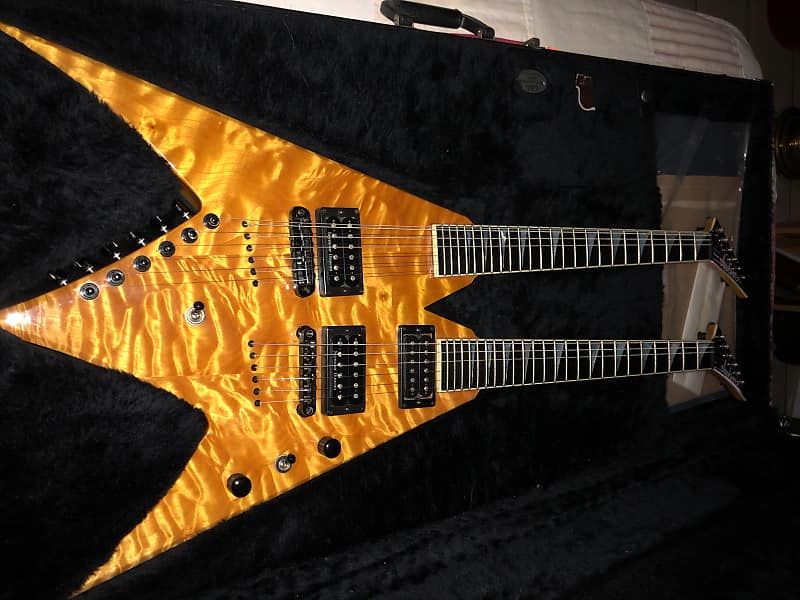
Jackson King V Pro
Fond of his King Vs, there was more to sell for Mustaine. This 1993 model was close to his previously played models and released in cherry sunburst, black and sparkle silver. Again, he chose Bill Lawrence pickups, the L500XL for the neck and a Jackson J-92C for the bridge pickup. Mustaine played these variations mostly during ‘Youthanasia’ and the following tour.
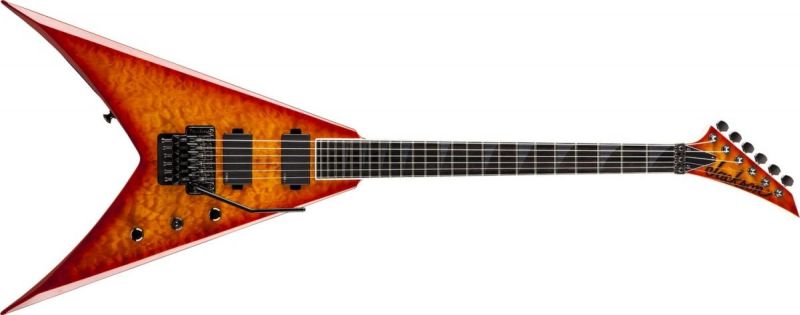
Jackson KV1
In 1995 the King V Pro model was renamed to KV1 and released officially as a Dave Mustaine signature model. While most people would recognise him from the sparkle silver King V. This model was dressed up to Mustaine’s requirements, but had different pickups, namely Seymour Duncan TB-4 and SH-4. Also different woods were used. Mustaine helped the sales of these guitars, which were made from 1996 to 2001, but he always kept on prefering his old customised guitar live. To those who have seen him play in this era, and saw him change guitars, there is a good reason they are called “flying V” by most, still. He often tossed them from center stage to his guitar techs.
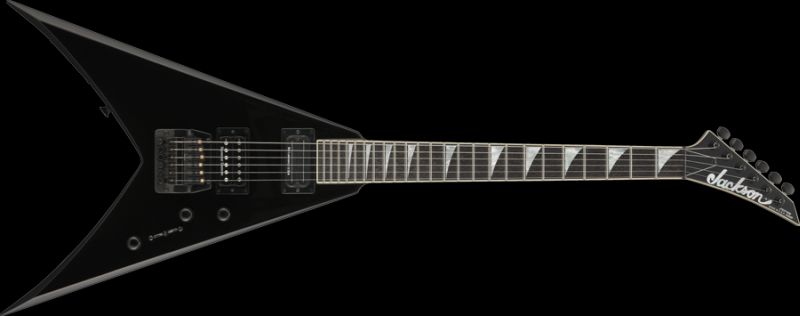
Jackson Y2KV Prototype J6442
The first in the line of Y2KV and Mustaine liked it a lot. Resembling traditional V-shaped guitars more, the guitar was released in 1998. Contrary to all of the other V guitars, this model had a headstock with three tuners on each side an rounded up edges, closer to the Gibson V. Although the guitars are more traditional in design, the first series are collector’s items today. The rounded up edges also gave the guitar a far less aggressive appearance, which suited the music of Megadeth better in those days. Mustaine tried several configurations and used a number of different guitars, but this was the one he felt the most connected to and would eventually lead up to the Y2KV.

Jackson Y2KV
This guitar went through the moulds in Asian factories in 2000. It was Mustaine’s main touring guitar for the tours after ‘Risk’ and ‘The World Needs A Hero’. Mustaine kept the settings as the prototype had them . The guitar had Seymour Duncan TB-4 and SH-4 pickups, Jackson JT390 Tune O Matic Bridge, Schaller tuners, and mahogany body and neck with 24 frets. He also had a custom American flag on it, and a “shut up” sticker in between the humbuckers.
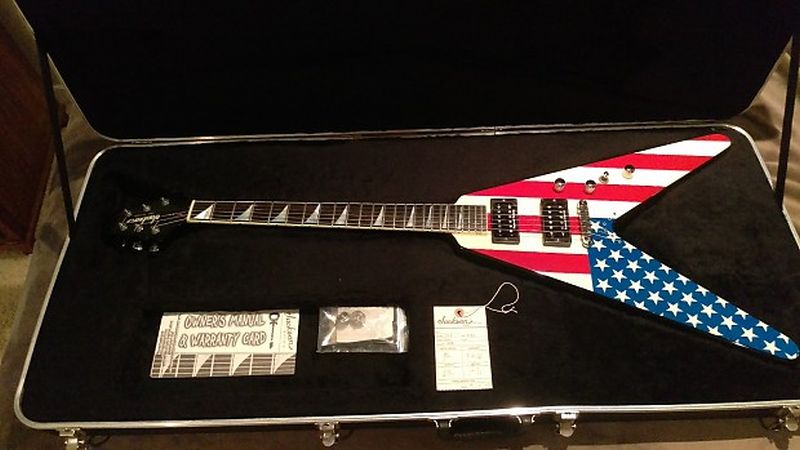
Jackson Y2KV Double-neck
Mustaine played this guitar in 2001, as the follow-up to his King V doubleneck. It had the same features with only a bridge humbucker pickup and 12 strings for the upper neck and two humbuckers (neck and bridge) on the lower 6 string neck. The double V makes a W in the curve, or an M, whatever you find more suiting to Mustaine of Megadeth. The finish below was never on the models he played.
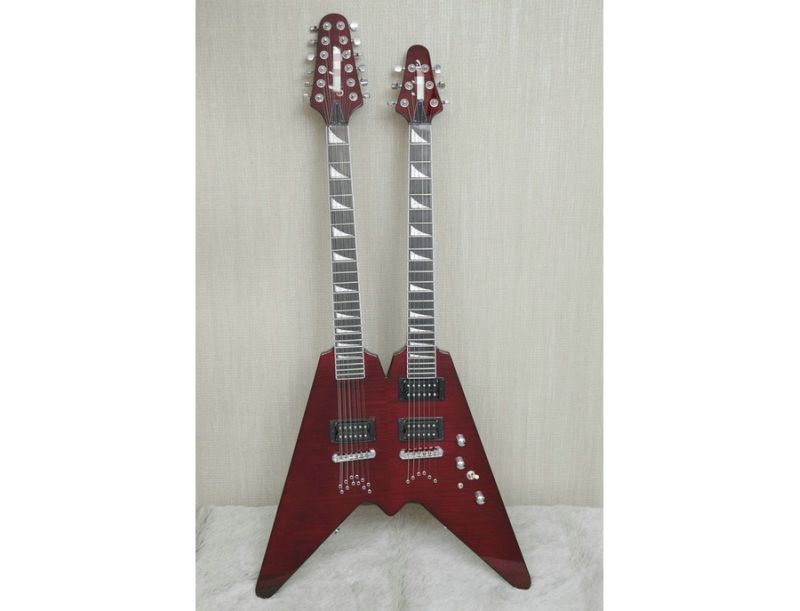
In january 2002, Dave Mustaine had a kidney stone removed. The medication did however not respond well with him and his substance abusing past. He therefore went straight from the hospital to a rehab centre in Texas. In the rehab, he fell asleep with his left arm over the back of the chair, after which his nerves were severely damaged. So much even he could not stretch, grasp or make a fist with his left hand anymore. Let alone play guitar. He therefore quit Megadeth and for a while, he had no hope of ever playing the guitar again.
“I went into retirement because my arm got hurt really bad. I broke up the band which at the time was Al Pitrelli, Dave Ellefson, Jimmy DeGrasso, and myself. I was having problems with Al because he liked to drink, and we didn’t want to show up at places with him drunk. Al also got married to a nice woman, but he wanted to spend time with her. After a few years, most married men are willing to die, so I figured if we got a couple years into the marriage that might have changed. But the fact was, Al wasn’t fitting. DeGrasso was really hard to be around because he was so negative all the time with his complaining about money and wanting things. Ellefson was all about ‘play my songs, play my songs.’ I hated being around these guys so when the arm injury happened, it was a welcome relief and an indication that I had to stop.”
Mustaine however found an alternative doctor who could help him beat the odds and he slowly regained his abilities. He had to learn how to play guitar all over again and he started with some acoustic solo projects. This was when Mustaine auctioned all of his Jackson guitars. All of them. Shortly after, it became apparent why, he had joined ESP Guitars, which built him a signature model.
ESP DV8
After recovery, he took the aid of a guitar teacher and Dave Mustaine was back from a point where he couldn’t have returned. This also sparked his new-found belief in God, which would have a significant influence on his views on life. Mustaine rekindled Megadeth in 2004 with an all-new line-up. Even founding bassist David Ellefson didn’t return for ‘the System Has Failed’, underlining that this is his band, and his vision and others are just side characters in his story. A new line-up, new playing techniques, and a new guitar deal, in a time when practically all of the Jackson artists went to ESP Guitars, since Fender didn’t have a clear picture of what to do with the brand at first. This ESP DV8 model was released in 2003, the first ever Dave Mustaine signature at ESP. The cuts were modified slightly, but other than that, he just seemed to have transferred his Jackson King V to ESP Guitars. He played other ESP V models too, on occasion. Off the record, those are his own kids in the video below.
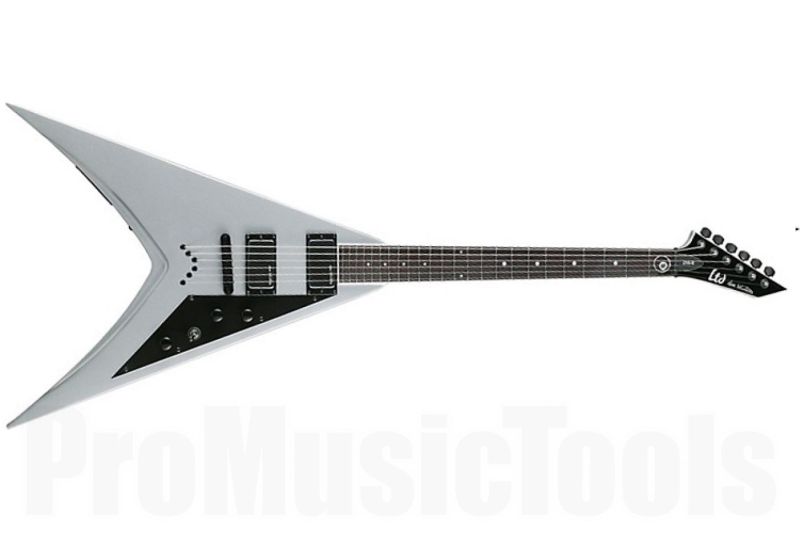
ESP Axxion
The model Mustaine had designed himself and Jackson had turned down for production. For obvious reasons. ESP however did release it to commemorate the 20th Birthday of the band (which had been dead for 2 years in between). The name is pronounced as “Action” and it had the usual 24 frets, Seymour Duncan TB-4/SH-4 humbucker set, Sperzel locking tuners, and TonePros locking bridge. And it is one of the ugliest guitars to ever grace Mustaine’s hands and possibly the ugliest guitar the wonderful craftsmen of ESP have ever built. I hereby challenge you to find one that beats that status.
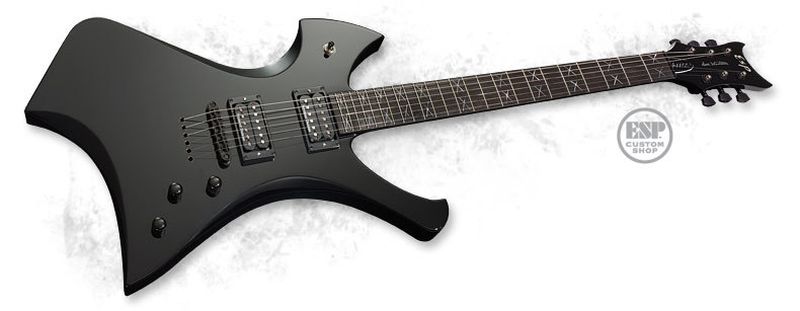
However, his marriage with ESP also ended in 2006, when he fell in love with Florida based brand Dean Guitars. Well, love…
“I have decided to leave ESP guitars. This was a business decision and had nothing to do with the guitars or the manufacturing of the guitars, and I wish the staff of ESP, both in the USA and in Japan and Korea the very best of health and prosperity”.
When he still was with ESP, he also started selling guitars he was given by them. Most of them were prototypes they wished for him to reflect upon. This put pressure on their cooperation and he left for Dean Guitars. He released several models at Dean Guitars, most of which were very successful.
Dean VMNT
The first ever Dave Mustaine signature at Dean was revealed in 2007 at NAMM. By bikini models, probably. From a distance it once again looked as if he transferred his Jackson King V to Dean, but the devil is in the details. There are cuts taken off the upper and lower legs of the V-shape and he now had self-designed pickups from Livewire Pickups. All of the V guitars Dean made were based on this one and they often had designs of the album artwork on them. Mustaine didn’t want the huge wings, the oversized headstock that Dean is known for, so he had a more modest headstock instead, with all tuners on top. This would be his main guitar for the years to come. He then took a slightly different turn.
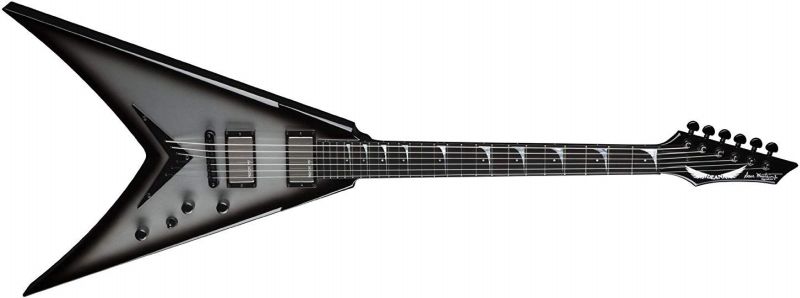
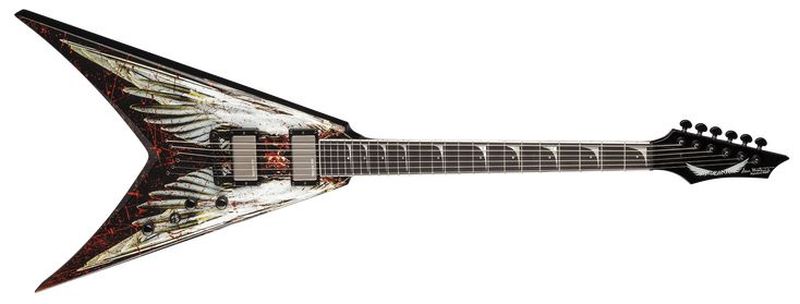
Dean Zero
Nobody saw that coming, after over 25 year Mustaine said goodbye to the V-shape for the Dean Zero in 2010. People will have associations with Marty Friedman’s Jackson Kelly from the 90s, but it has its own characteristics and specifications. And the headstock was used from the Dean VMNT, as were the other specs.
This model provided more space to display the album artwork, the artwork of ‘Dystopia’ in the case below. Other than that, it felt a bit strange to see Mustaine with this Explorer-like model, after being used to seeing him on a V for so long.
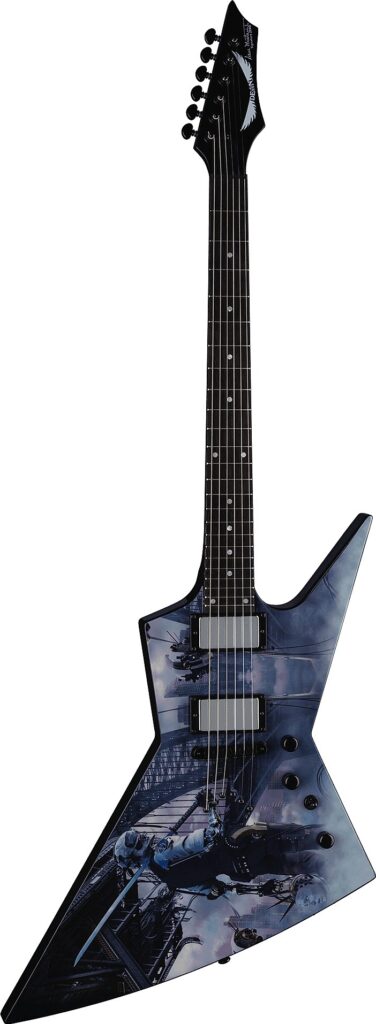
Dean V Dave Mustaine Doubleneck
What Jackson could do before them, was the new challenge for the master luthiers at Dean guitars. Having built the insane Michael Angelo Batio ambidextrous guitars before, with 4 necks, they accepted the challenge to build Mustaine his own doubleneck V. The features were similar to his King V and the specs were similar to his other guitars.

Acoustics
Besides his electric axes, Dave Mustaine also used a variety of acoustic guitars. Ovation Tangent T357 in 2001, with an OP-30 built-in pre-amp; Dean Mustaine Mako Acoustic is two different finishes, one black and one with the Star Spangled Banner.
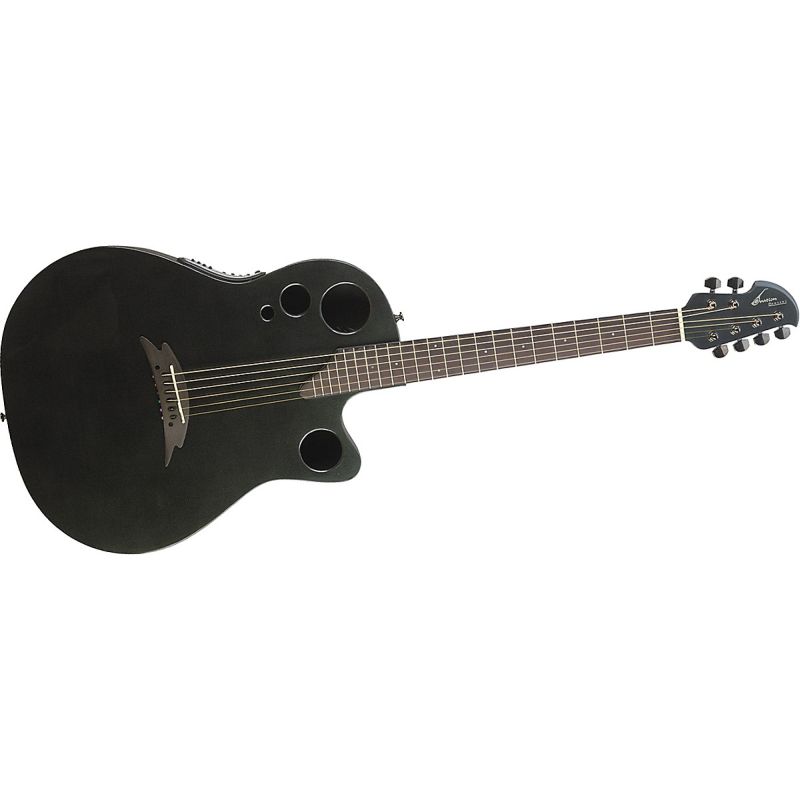
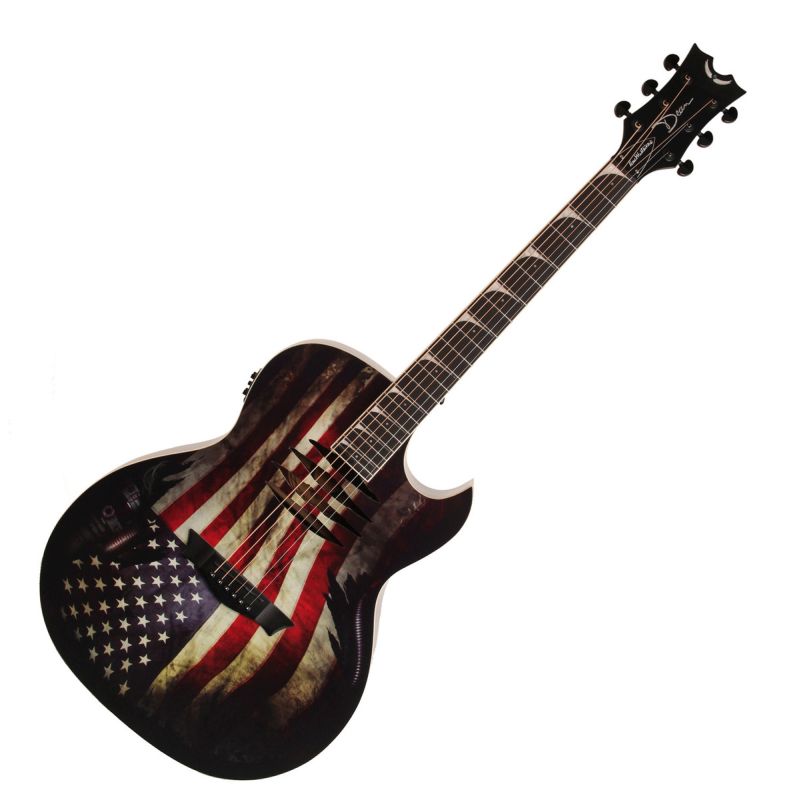
Gibson
And today Gibson announced the new Dave Mustaine cooperation, which he hinted about in the days ahead on his Facebook page. The new Dave Mustaine Collection will span acoustic and electric guitars across Gibson, Epiphone and Kramer.
Dave Mustaine: “One of first albums I ever bought was ‘KISS Alive’. On the back of that LP was the Gibson logo, followed by ‘KISS uses Gibson guitars because they want the best’. Years later, I’m still that same fan, but now I’ve been playing, touring, writing, and performing around the world myself, and I can say that I could not agree more with that statement. As I was looking for a change in my guitars, I met with Cesar and got his perspective on the vision and direction Gibson is taking. I saw passion, respect for the instruments, a focus on quality and a company that is led by guitar players. I feel I am finally at home with Gibson and I am proud of what we’re building together. I can’t wait for the world to get their hands on the new Gibson, Epiphone and Kramer Dave Mustaine Collection guitars. This is a dream come true for me, don’t #@!# wake me up.”
Cesar Gueikian of Gibson Brands: “It’s an honor to welcome icon, pioneer and visionary musician Dave Mustaine to the Gibson family as our brand ambassador”. Dave is one of the most influential metal icons and riff lords of all time, having paved the way for multiple generations of players to carry the flag for hard rock and heavy metal, from riff writers to shredders and everyone in between. Working with Dave is especially gratifying because he is a guitar nerd like me, who gets involved in every aspect of the development of the concepts and ideas we have been designing with him at the Gibson Lab. When I was as kid learning how to play guitar, I aspired to play Dave‘s riffs and I was one of the fortunate fans who attended their ‘Youthanasia’ tour concert at Estadio Obras Sanitarias in 1994, in Buenos Aires, Argentina, where the ‘Aguante Megadeth’ chant was born over the song ‘Symphony Of Destruction’. That was an epic night that I will never forget. I look forward to bringing this partnership to life and unveiling the first stages of the Dave Mustaine Collection to the world.“
Check de onderstaande socials voor meer informatie over ESP Guitars.
